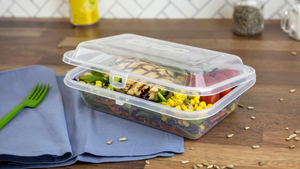Building stack molds for efficiency and higher productivity
September 22, 1998
|
While not right for every application, stack molds can offer increased productivity within existing shop space. (Pictured: Doug Miller, sales manager of mold manufacturing at Precise Massie.) |
Precise Massie (St. Petersburg, FL) recently completed two large tooling programs involving the construction of stack molds, and it has more stack mold programs in the works. According to Ed Cigoi, plant manager, Massie has received twice as many quotation requests for stack molds in the last year as it has in previous years.
Precise Massie began developing its expertise in stack molds when it was acquired by Precise Technology (North Versailles, PA) in 1996. It is one of three mold manufacturing facilities owned by Precise. Prior to that time, Massie's work had been primarily in the area of multicavity, multi-mold projects. Cigoi says building stack molds definitely involves a learning curve.
"It's a technology most moldmakers do not want to get into," says Cigoi. "Stack molds can become very complex, especially when you are building them for applications in the electrical, medical, and healthcare product industries."
Cigoi says Precise Technology brought its stack mold knowledge and expertise to Massie and encouraged the company to begin building the molds. Precise gained its stack mold expertise during the development of its Delaware CAP facility, which runs stack molds exclusively. According to Cigoi, "With Precise's resources and people, such as Ron Seegers, vice president of mold manufacturing, ensuring our success, we are now able to offer stack mold technology to our customers."
Two Success Stories
Working in conjunction with Husky Injection Molding Systems (Bolton, ON), Precise Massie designed and built a 2x4 stack mold weighing in at 26,500 lb. The mold contains a Husky hot runner valve-gate system and runs in a Husky GI/600 press. Husky shipped the press to Precise Massie's test center where the mold was sampled and fine-tuned. Then, both mold and press were shipped, as a unit, to the end-user.
Precise Massie also completed a 2x8 stack mold for Paragon Plastics (Union, SC), which will run in a 700-ton Cincinnati Milacron press. While Massie didn't have a test press large enough to sample the mold in-house, the company sent a start-up team with the mold to the customer's facility for trial. The mold was up and running parts in three hours.
For both Massie customers, choosing a stack mold meant increased productivity and efficiency. In Paragon's case, the company was able to double its capacity using existing equipment and the same amount of floor space. A stack mold-essentially two molds back-to-back sharing a common plate-doubles the cavitation without the need to increase press size. (The height and width of a stack mold are normally not much larger than a conventional, single-faced mold except for deep parts.)
More Capacity, Same Space
According to Cigoi, the decision to use stack molds boils down to getting more capacity without increasing the customer's capital expenditures and, thereby, reducing price per part. "Stack molds are obviously not for all product applications," says Cigoi, "but we offer this option to our customers when we feel the return on investment warrants it."
Stack molds have been used extensively for smaller, flat parts such as bottle caps, small food containers, and lids. However, both stack molds discussed here were for medium-sized parts with complex geometry for the telecommunications industry.
In recent years, Precise has seen customers from a variety of industries looking at stack molds for high volume applications, including the electronics, video, and personal care markets. However, while more people are investigating stack molds to increase productivity and reduce costs, there is still a reluctance on the part of some OEMs and molders to go the stack mold route. For one thing, handling stack molds requires large support equipment such as overhead cranes.
Cigoi feels, many times, the biggest reason people don't use stack molds is simply a lack of expertise running them. "They feel uneasy," Cigoi explains. "They would rather stick with single-faced molds and add presses to accommodate increased volume requirements."
To assist its customers with such concerns, Precise Technology provides a technical team that accompanies the mold to the customer's facility on every mold startup. "We found if we assist our customers with the startup and provide on-site technical training, our customers are in production much sooner," comments Seegers. "and if there is a startup tool problem, we can react immediately."
Contact information |
You May Also Like



